June 24, 2004
Talking about Painting
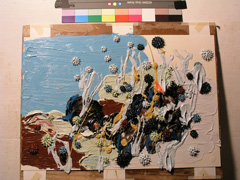
It's time to kick back and assess the situation here. After the fiasco of the past several days, it'd be good to look back at the stuff I've done since we settled down here in Tossa.
A caveat: what follows is a rumination, a blog entry... not a scholarly effort by a long shot, with no pretense to portray something ultimate or final.. certainly this will not be a last word. I hope not. This is my best effort: just me, this here laptop/keyboard and an hour or so to hammer it out. It's almost stream of consciousness, just peel the tab and pour it out.
Well, almost... kinda like that. But better.
Since there will be a few images, I thought it best if you click on the "Continue Reading" linky thingy below here:
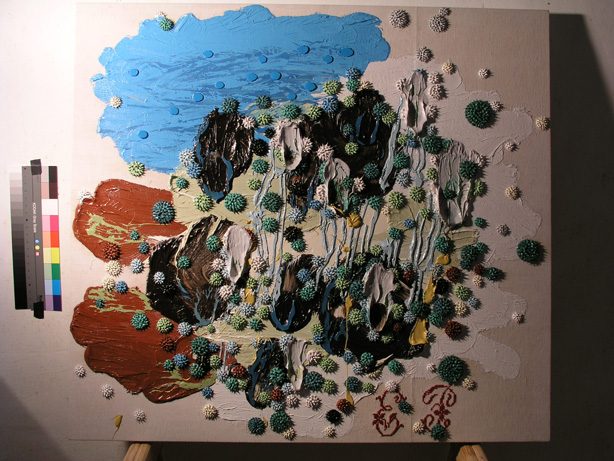
This is the very first painting. I was looking at the multitude of landscape paintings and other images of the sea here in Tossa's Costa Brava. I know it was handling high voltage kitch, but since I like to wrench away the armature of representation (ok, the word "wrench" is dramatic, maybe I nudge... or maybe I flip the toggle between abstraction and representation back and forth nervously), I thought it would be interesting here to simply weaken that armature (in this case the schema of landscape), and instead of flipping it upside down like Baselitz or dragging imagistic patches like Bacon or to simply ignore representation like a multitude of artists good and bad, I think here I would just let it sag and crumble a bit.
(I'm visualizing some skeletal thingy that would collapse with the slightest breeze and parts of it already have, bits dropping away as you touch it like a dusty spider's web.)
As so with the landscape, we can summon the parts in a roll call: A blue sky, a white wash, clay earth, the jostle of patches of material articulated against a horizon line.
In this first painting done in Spain, I was charmed. The checklist of a good painting (for me of course):
- I had a rough mental image of it beforehand. This isn't always the case, or at least the initial image is redrawn several times and certainly some very exceptional ones were of that type. I mean, This previsualization wasn't a clear mental image. For example, the two masses of Indian Red (or terracotta-ish) paint on the left did not have a certain coordinate that matched my mental image. I felt a need for the weight that that color delivers and I put these masses on with a Dowser's thrust.
-The masses of initial paint all had a good angular attitude (I know that probably means much more to me than you, but hang in there).
-Everything hung together, each requiring the other. Every imprint of paint left large aspects that were admirable and small aspects that were not, and the activity of what I consider progressive editing (applying succeeding touches of paint onto the parts that are not up to snuff...) followed one after another in a nice arc of dimishing proportions to the end.
-There is a maximum amount of frission, the dynamics of paint forms licking into paint forms in a fragile skein. Entanglement. An entanglement of paint entangled in the entanglement of seeing. (Whew! I had to write that.)
-While there cannot be pure abstraction (we tend to see things into things anyway... or maybe it is that abstraction can only be a conditional, temporary suspension of an imagistic human reflex... see the colophon on the left margin of this blog) and while I imagine my work as retasking the motors of representation in the service of an abstract project (I have the mental image of a car engine being lifted out from a car), this was a painting that hung together without abandoning the primacy of paint for the primacy of image.
I knew the first painting would be charmed. After not painting for so long, with the interlude of thoughts of painting at a distance and enjoying the the freshness of a new place to paint, I could just feel it there. Relief and release. And I knew before, during and after this initial painting, that the ones that follow would have to overcome the pattern of expectations that this painting would provoke in me. There are those patterns which inform a body of work and there those patterns that inform one from the train of paintings of which the body is comprised. I wouldn't want to know the nature of the ultimate body (that would make painting as a verb uninteresting, and I think that it has to be interesting in a way that makes painting as a noun interesting) but it is crucial that each succeeding painting is of interest in and of itself, regardless of where it is on the train.
Yea, I know I'm swooning on my violin (eyes closed, brow knitted, tippy toe...). Let me reel us in thusly:

Like I was saying, I didn't want to paint the first painting again, but I wanted to apprehend any lessons it offers that would... charm (I like that word)... the ones to come. First of all, I stopped relying on the initial background uniform vertical screed I had done before for nearly all the paintings since the beginning of this series. I had started with loads of paint on drywall knives pulled down across the surface, and this provided the initial condition of wetness for the slap-happy highjinks to come. (I'm feeling a little slap happy right now, sorry if this language is getting ripe.)
This first move usually dominated the painting surface and it dominated time. While it was great in the beginning, I had become aware of the limitations too. One limit is size. Once I lay the paint, the clock is on. By scrubbing the paint on with my home made pads in large patches, I realised I was no longer committed to painting the entirety of the surface at once. In other words, I could take on any size panel with a piecemeal strategy... kinda like the way I imagine murals are painted: one section at a time.

Now, I didn't exploit this capability in this second painting. And I tentatively twitched in that direction in the third one. Here in the second one, I agitated against the landscape schema by flipping things; skyblue below, masses left and right that don't service a horizontal narrative. It was almost as if a camera tilts down and the horizon line disappears from the top.
What I had then was a contest of masses and the only way to bring this painting to realization was to increase the pressure of internescine daub, flick and mark of paint. I reach for the words to describe this: I like the word "fission" but it is really about splitting atoms. It sounds like "frisson", a word that's very French and sophisticated but means shudder or thrill. Or better, "fusion" and this is the best because it evokes liquifaction and plasticity. Goldilocks that I am.
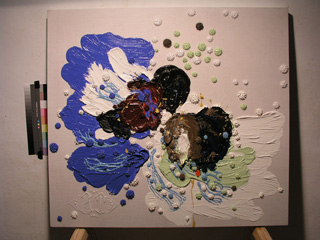
In this third painting, I wanted some breathing room again. I focused on the initial masses of paint, white and (French) blue, and I looked for more restraint and tension as opposed to the melee of the previous one. Along the way, I found another painting, so I shot this picture as a souvenir for the possibility of something to come:
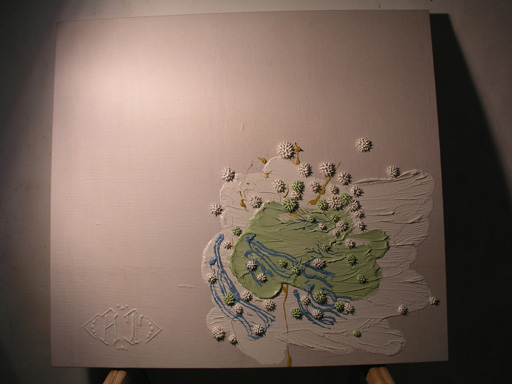
Here, you can see the monogram that was sewn into the orignal linen cloth native to this region. This wasn't an original intention but it was something that presented itself and I let it manifest itself with ease. After all, my very first paintings relied on the final inscription of letters and alphabet forms that were twisted and morphed away its' original signifying intention. I thought it was serendipitous. Kismet.
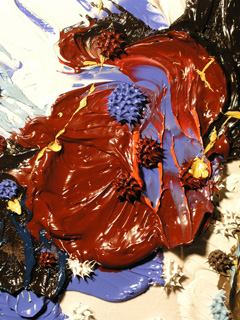
I have begun to let the masses show themselves a little more too. I like the swell of paint and the rivulets and streams of peaks and valleys of the material. And I had this desire to continue to lay in the darker burnt umber masses and counter the creamy white passages.
This painting also was a primitive attempt at sectioning parts of the surface piecemeal. The two images above illustrate this pretty well. I imagine that I could paint any size surface with this method. I wonder however, if the other baggage of the mural technique would apply too? For example, cartoons, or plans that anticipate a final result. The predetermination could be a problem. Instead of intricate drawings, I could work with colors and massing. It could be interesting to do studies beforehand, the "drawings" (I am imagining early Rothko like color studies) could be cool. But you never know.
As I painted past a future painting and brought this one to completion, I saw another possibility in painting in larger panel sizes. I could lay in the initial areas of paint and scrape them off, creating large areas of flat color. This could dominate the surface and scribe a srawing that can be seen in the outline of the initial color form. If you take this large area dominating image of color/shape and combine it with the singular patch (seen in the painting in progress image above), that could be pretty interesting. So I stumbled in that direction in this next panel:
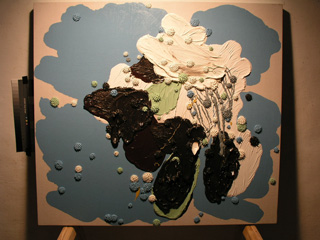
I use the word "stumble" not as a pejorative, but one limitation that I had come to appreciate was this idea of large area color/form as the drawing that would carry isolated, figuring episodes of paint gnashing demmanded larger panels that what I have at the moment. In the last aborted panel, I realized that it might be better to combine two such panels together to make the dimensions I need for the realization of this idea.
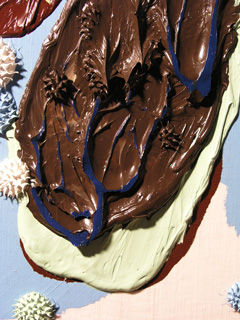
(Note: I will probably fine tune this entry as time goes on. If this note disappears, then you'll know I'm done.)
Posted by Dennis at June 24, 2004 10:05 AM
Leave a comment